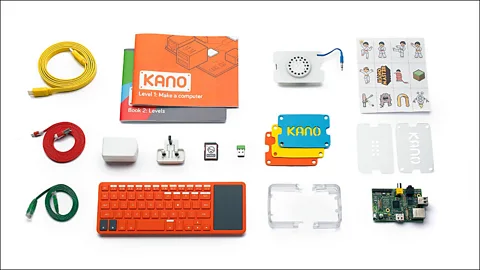
Build-it-yourself computer kits led to the creation of PCs and Bill Gates. With a new wave that includes 3D printers, drones, and even biotech, what will be possible?
In early December last year, first-time entrepreneur Alex Klein was amazed. After designing a $100 build-it-yourself computer kit called Kano, Klein and his team aimed to raise $100,000 on the crowdfunding site Kickstarter to start producing their first kits.
Kano is described as “a computer anyone can build,” featuring a Raspberry Pi (a basic, credit-card-sized single-board computer), a keyboard, an operating system, games, and a speaker.
Klein and his co-founders had modest expectations. “$100,000 didn’t seem low to us at the time. We were just starting out,” he says. Yet, in just thirty days, they exceeded their goal by 15 times, raising $1.5 million and receiving pre-orders for 13,500 kits. “We were shocked,” he recalls.
Kano’s surprising early success comes at a time when the DIY kit-building culture—covering self-built 3D printers, drone kits, and even backyard biological hacking—is thriving. It also has roots in a rich history of tools that have enabled people to explore and rebuild the latest high-tech innovations.
While some might see these kits as simple hobbyist toys, their creators claim they help drive a cycle of innovation that leads to some of society’s greatest technological breakthroughs. Is this really true? Are there broader social benefits to self-build kits? And if so, what technologies or industries might we see being “hacked” next?
Modern build-it-yourself technology kits have been around since at least the early 20th century. In 1926, The Heath Company started making a kit-aircraft called the Heath Parasol, and in 1947, they launched their first electronic kit, the 01 oscilloscope, which measures electricity. Twelve years later, they introduced the EC-1, a desktop computer kit for under $200, which included vacuum tubes, sockets, capacitors, resistors, and other components for self-assembly.
These early kits succeeded in making advanced technology affordable for enthusiasts. They also attracted fans who would go on to create world-changing innovations. In an interview with Computer World, Steve Jobs described what he found appealing about Heathkits. “It gave a tremendous level of self-confidence, that through exploration and learning one could understand seemingly very complex things in one's environment.” Jobs explained that with Heathkit experience, you might look at a TV set and feel confident enough to try building one.
In the mid-1970s, computer kits began to gain popularity. In 1974, the cover of Popular Electronics, the world’s largest electronics magazine at the time, featured the $400 MITS Altair 8800 microcomputer. It was at least a thousand dollars cheaper than its competitors.
